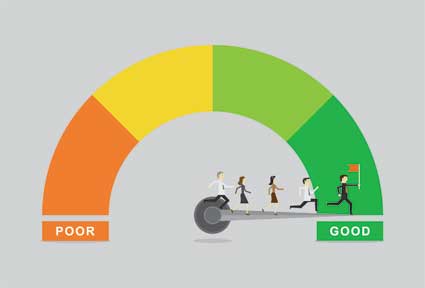|
Two Main Types of Obligatory Securities and Exchange Commission Filings |
|
Form 10-K: The 10-K form is the audited annual report that gives a comprehensive detailed overview of the financial activities for a business over the past year. This includes the four financial statements which are discussed further in this article. The 10-K also provides notes will from the management's discussion and explanations of the financial activities of a business throughout the year along with management team's analysis of the financial results business over the past year. |
|
Form 10-Q: The 10-Q form's quarterly report for a business that provides a detailed view of the performance and financial position for a company. The 10-Q also includes complete summary versions of the four financial statements as well as some limited additional disclosures from the management team of the business. |
Additionally there other common SEC filings which are known as:
-
Form 10K/A and Form 10-Q/A: With these forms the "A" designation is intended to refer to an amended version of the previously filed Form 10-K or Form 10-Q. These amendments take place usually because of an error or an accounting change from the original form that needs to be reported to the Securities and Exchange Commission.
-
Form 20-F: This form must be submitted by "foreign private issuers", in order to help reconcile and balance the accounting statements to the United States GAAP rules and standards.
|
Learning Objectives |
|
|
|
|
The Balance Sheet:
The balance sheet is considered to be one of the most important financial statements. The balance sheet for a business shows the financial position of the business at a point in time. You can think of the balance sheet like a snapshot or photograph of the company's financial well-being for particular point in time. The balance sheet lists the businesses resources also known as assets (what the business owns). There are also multiple ways to convey information on a balance sheet. Many accountants use the traditional style of writing a balance sheet; however there are also consolidated balance sheets, and condensed balance sheets. Consolidated balance sheets apply in cases where a large company may have a smaller subsidiary business and the consolidated balance sheet then takes the assets from the "parent" company and combines them with the assets of one or more of the subsidiary or "child" companies. There is also the condensed form of the balance sheet, which is used for quick evaluations because it reduces all of the information that is reported on a traditional balance sheet into just a few lines. The balance sheet also reports the sources of asset financing for the business. There are two common ways that a business can finance its assets. These two methods are known as owner financing and non-owner financing.
|
Sources of Asset Financing |
|
Owner Financing: When a business raises money from it shareholders. |
|
Non-owner Financing: When a business raises money from a lending institution such as a bank or other creditors and suppliers to the business. |
By having two ways the business can finance its assets, this means that both owners as well as non-owners will hold legal financial claims on company assets. Generally owner claims on assets are better known as equity, while non-owner claims are known as liabilities (debt). Due to the fact that all financing must be invested in something, we are able to derive the basic relationship of investing equals financing. This relationship is better known to most people as the accounting equation.
|
The Accounting Equation: |
|
Assets = Liabilities + Equity |
|
The accounting Equation can also be represented as: |
|
Investing = Nonowner Financing + Owner Financing |
|
WH3 Corp. |
||
|
Balance Sheet |
||
|
For the Period Ending December 31, 2014 |
||
|
2014 |
||
|
Assets |
||
|
Cash |
$450,000.00 |
|
|
Noncash Assets |
275,000.00 |
|
|
Total Assets |
$725,000.00 |
|
|
Liabilities & Equity |
||
|
Total Liabilities |
$320,000.00 |
|
|
Equity |
||
|
Contributed Capital (Common Stock and Paid-In Capital) |
315,000.00 |
|
|
Retained Earnings |
30,000.00 |
|
|
Other Equity |
35,000.00 |
|
|
WH3 Corp. Equity |
$380,000.00 |
|
|
Non-controlling Interest |
25,000.00 |
|
|
Total Equity |
$405,000.00 |
|
|
Total Liabilities & Equity |
$725,000.00 |
|
* Details of financial statements often begin with the word consolidated which means that the financial statement includes either the parent company and potentially one or more subsidiary companies for whom the parent company has a controlling interest.
The concept of the accounting equation is evident when examining the balance sheet for WH3 Corp. the balance sheet shows the following amounts for:
• Assets = $725,000
• Liabilities = $320,000
• Equity = $405,000
The Income Statment:
In addition to the balance sheet the income statement is considered to be one of the most important financial statements for a business. The income statement shows a business's performance over a period of time and lists the revenue amounts also known as sales for a business, as well as the expenses for a business. In order to get the net income for business you must take the revenues for business less the expenses. For instance referred to the income statement of WH3 Corp.
|
WH3 Corp. |
||
|
Income Statement |
||
|
For the Period Ending December 31, 2014 |
||
|
2014 |
||
|
Revenues |
$165,000.00 |
|
|
Expenses |
125,000.00 |
|
|
Net Income |
$40,000.00 |
|
|
(Less) Earnings Attributed to non-controlling Interest |
$25,000.00 |
|
|
Net Income attributable to WH3 Corp. Stockholders |
$15,000.00 |
|
Many businesses that are involved in manufacturing as well as merchandising generally include an additional expense account in their financial reports known as the cost of goods sold or COGS. The cost of goods sold is also known as the cost of sales, in the income statement after revenues. Additionally, many businesses commonly report subtotal known as gross margin also called the gross profit, which is calculated by taking the revenues less the cost of goods sold. Refer below to see a simple process flow of the income statement and its layout.
|
Revenues |
||
|
– |
Cost of Goods Sold (COGS) |
(Cost of Labor and Materials) |
|
= |
Gross Profit |
Revenues less COGS |
|
– |
Expenses |
Expense Other Than COGS |
|
= |
Net Income (Loss) |
The Statement of Stock Holder's Equity:
Another important but less common financial statement is the statement of stockholders equity. The statement of stockholders' equity shows the material changes in the equity of a business for the reporting time period. For the various types of equity the statement of stockholders equity shows the beginning balance, a general summary of activity in the account over the reporting time period, as well as the ending balance. The statement of stockholders equity for WH3 Corp., which is shown below shows how equity for the company went through various changes because of income reinvestment as well as issuance of shares in the business. Take a look at how WH3 Corp. reports and classifies the various types of changes into four main components:
|
Categories listed in WH3 Corp.'s Statement of Stockholder's Equity |
|
1.) Contributed Capital- These are the net contributions made by the stockholders to the company. |
|
2.) Retained Earnings- This is the net income of the business over the lifetime of the business minus all of the dividends that have ever been paid out. |
|
3.) Other- This consists of metrics. |
|
4.) Non-Controlling Interest- This is the equity of outside stockholders/ shareholders for the business. |
|
WH3 Corp. |
|||||
|
Statement of Stockholders' Equity |
|||||
|
For the Period Ending December 31, 2014 |
|||||
|
Contributed Capital |
Retained Earnings |
Other Equity |
Non-Controlling Interest |
Total |
|
|
31-Dec-13 |
$37,815.00 |
$109,448.00 |
$17,587.00 |
$4,111.00 |
$168,961.00 |
|
Stock Issuance (Repurchase) |
118.00 |
-1296 |
-1178.00 |
||
|
Net Income |
14824.00 |
488.00 |
15312.00 |
||
|
Dividends |
0.00 |
0.00 |
|||
|
Other |
-695.00 |
9846.00 |
-658.00 |
8493.00 |
|
|
31-Dec-14 |
$165,000.00 |
$165,000.00 |
$165,000.00 |
$165,000.00 |
$191,588.00 |
Statement of Cash Flows:
The statement of cash flow will report the change in a company's cash balance over time. This change can either be an increase or decrease in the cash balance. Statement of cash flows is useful for providing detailed reports of the cash inflows and cash outflows for business from operating, investing, and the financing activities for a given period in the business cycle. The statement of cash flows for WH3 Corp. listed below.
Notice of the company's cash balance increased by $9.6 billion in the most recent period. The operating activities of the company generated $20.9 billion in cash inflow while the investing activities of the company reduced the cash by $10.5 billion, and the financing activities returned the cash outflow of $683 million. The operating cash flow for WH3 Corp., in this period is not equal to the net income that is generated for the same period. The cash flow as well as the net income numbers are extremely important when making business decisions. Each metric is used in what is known as security evaluation modeling and both metrics help business owners and investors to use accounting reports understand and assess the past and future trends of a business and its activities.
|
WH3 Corp. |
||
|
Statement of Cash Flows |
||
|
For the Period Ending December 31, 2014 |
||
|
2014 |
||
|
Operating Cash Flows |
$20,950.00 |
|
|
Investing Cash Flows |
$(10,574.00) |
|
|
Financing Cash Flows |
(683.00) |
|
|
Net Increase in Cash |
$9,693.00 |
|
|
Cash on December 31, 2013 |
37,299 |
|
|
Cash on December 31, 2014 |
$46,992.00 |
|
How Financial Statements are Interlinked:
The accounting information that is reported in the four financial statements are linked both across and within periods. It is important to note the following:
-
Retained earnings, contributed capital, as well as other equity balances show up on both the balance sheet as well as the statement of stockholders equity.
-
The statement of cash flows is cross-linked to the income statement due to the fact that net income is a component of operating cash flow. The statement of cash flows is also concurrently leaked to the balance sheet due to the fact that a change in the balance sheet cash account reflects the net cash inflows and outflows for the reporting time frame.
-
Both the balance sheet as well as the income statement are links to each other through retained earnings.
|
KEY POINTS REVIEW |
|
1.) The Balance Sheet 2.) The Income Statement 3.) The Statement of Stockholders' Equity, and 4.) The Statement of Cash Flows |
|
|
|
|
|
|


























